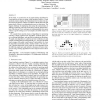Free Online Productivity Tools
i2Speak
i2Symbol
i2OCR
iTex2Img
iWeb2Print
iWeb2Shot
i2Type
iPdf2Split
iPdf2Merge
i2Bopomofo
i2Arabic
i2Style
i2Image
i2PDF
iLatex2Rtf
Sci2ools
89
Voted
APVIS
2007
2007
A comparison of vertex ordering algorithms for large graph visualization
In this study, we examine the use of graph ordering algorithms for visual analysis of data sets using visual similarity matrices. Visual similarity matrices display the relationships between data items in a dot-matrix plot format, with the axes labeled with the data items and points drawn if there is a relationship between two data items. The biggest challenge for displaying data using this representation is finding an ordering of the data items that reveals the internal structure of the data set. Poor orderings are indistinguishable from noise whereas a good ordering can reveal complex and subtle features of the data. We consider three general classes of algorithms for generating orderings: simple graph theoretic algorithms, symbolic sparse matrix reordering algorithms, and spectral decomposition algorithms. We apply each algorithm to synthetic and real world data sets and evaluate each algorithm for interpretability (i.e., does the algorithm lead to images with usable visual featur...
Related Content
| Added | 29 Oct 2010 |
| Updated | 29 Oct 2010 |
| Type | Conference |
| Year | 2007 |
| Where | APVIS |
| Authors | Christopher Mueller, Benjamin Martin, Andrew Lumsdaine |
Comments (0)

